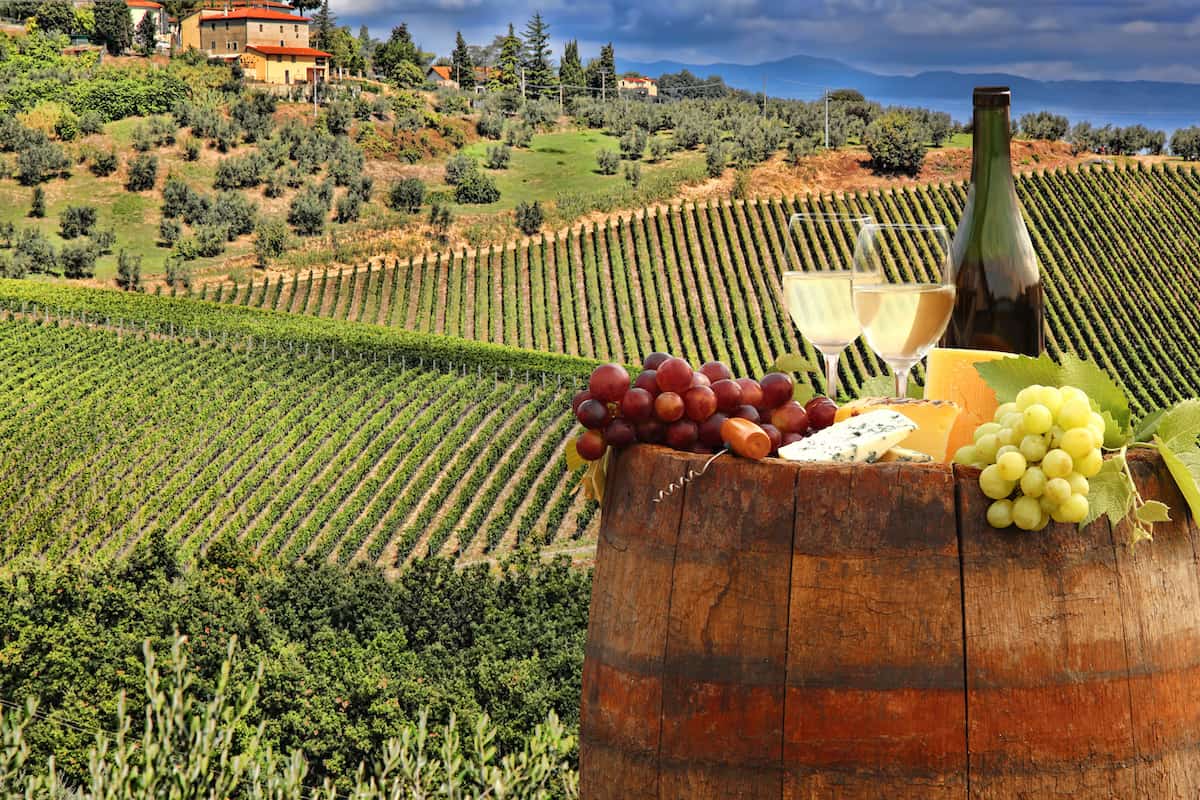Contributing writer Ali Webb visits six Tuscan vineyards—sipping wines from Montalcino to Montepulciano—and reignites her love for the region’s many lures.
Whenever I return to Tuscany, I’m reminded of what Leonardo da Vinci famously said, “Tuscany is the ultimate canvas, painted with the hues of history and culture.”
Each trip I take paints a more vivid set of colors on my happy memories of this Italian region. Every stone wall, every vineyard, and every rolling hillside—framed in tall cypress trees—fills me with a sense of tranquility.
The Tuscany of my memory boasts a golden light, illuminating the countryside with a warm glow, and the smell of lavender and rosemary perfume the air. That is my mental painting of Tuscany, recreated every time I visit.
Tuscany’s landscapes of rolling hills have been memorialized in so much art, both visual and other mediums. Who can forget Frances Mayes’ book and the 2003 movie Under the Tuscan Sun, when many of us were ready to dump our lives and find our own deteriorating villa to renovate?
Heading to the Tuscan Vineyards

Tuscany is located in central Italy and has about 3.8 million people. When traveling there, we usually arrive at the Leonardo da Vinci Rome Fiumicino Airport (named for da Vinci), rent a car, and drive up the well-maintained highway. It is a three-plus-hour trip, give or take.
A trip to Tuscany would not be complete without visiting a few of our favorite Tuscan vineyards. Each offers a slightly different experience, fabulous wines, and warm hospitality.
These Tuscan vineyards are more than just places where grapes are grown—they are part of the region’s history, each with its unique story and character. Tuscany’s grapes, notably Sangiovese, Canaiolo, Trebbiano, and Vernaccia, combine to delight any level of wine lover, from beginner to expert. And there are so many vineyards to choose from!
The just under 12,500 producers who made 60 million gallons of wine in 2022 give real meaning to the saying “so many wines, so little time.”
Our Favorite Tuscan Vineyards
Finding bad wine or ugly Tuscan vineyards is difficult, but here are six of our favorites to help you create your own Tuscan wine tour:
Poggio Rubino

Poggio Rubino in Montalcino is renowned for its Brunello di Montalcino. On our last visit to the winery, we sat tasting in the well-appointed tasting room in a charming stone building, and the wine lived up to its reputation.
The winemakers here are guardians of a centuries-old tradition. They meticulously tend their vines to produce exquisite and evocative wines of the region’s rich heritage. In 1997, with the help of his grandmother, Edward Corsi bought a small parcel. He was joined by Allessandra Marzocchi, an agronomist who helped him build the winery.
The rich soil of Montalcino wineries allows them to cultivate and produce two wines: Brunello di Montalcino and Rosso di Montalcino. Both wines are made from Sangiovese but have different characteristics and aging potential. The winery offers a wine club, so you can always keep a bottle on hand.
Sesta di Sopra

The vineyard owner of Sesta di Sopra, Ettore Spina, is a white-haired grandfather who proudly serves his wine in his slippers when guests visit for a tasting.
During our most recent visit to this Montalcino winery, his wife looked on to ensure he didn’t open too many bottles. This family-run vineyard offers a deeply personal glimpse into the winemaking process, which is intertwined with family traditions. The Tuscan wines here reflect their makers—complex, robust, and deeply rooted in the land.
In the late nineties, the couple started making wine on their vacation property in Montalcino from vines they had planted 20 years earlier. Today, they produce a relatively small annual production of less than 12,000 bottles, specializing in Brunello.
La Braccesca
A visit to La Braccesca, owned by the esteemed Antinori family, is a culinary and cultural delight and at the other end of the spectrum from Sesta di Sopra.
Located near Montepulciano, this vineyard comprises 1,200 acres and has a stunning tasting and retail building. Our tasting featured four wines. Then, over lunch in the same sunlit setting, we ate a lovely local meal paired with additional wines.
I wish we had time to attend their cooking school and learn to make pici, a handmade pasta typical of southern Tuscany.
Baldetti
At Baldetti, Michael, the winemaker, personally served the Tuscan wines, offering insights into the exacting process that goes into each bottle. This is a truly family affair, as Michael’s father, Mario Baldetti, now works with Michael’s two sons, Daniele and Gian Luca.
Each sip is a journey through the terroir of nearby Cortona, which has only been a specified domain or DOC since 2000. They also offer cooking classes, including pasta making.
Collemattoni
Collemattoni is located on a hilltop on the south side of Montalcino. Our wine-tasting tour was led by a knowledgeable lady, Gabriella, who shared stories of the vineyard’s past and present as she took us through the cellar and bottling areas.
The farmhouse, from which the winery takes its name, adds charm. Its history dates back to the end of the 17th century. The Bucci family crafts its wines carefully and passionately, reflecting the region’s unique characteristics.
Casanova di Neri

At Casanova di Neri, owner and winemaker Giovani di Neri stops by our table, adding his 30-year history at the winery to the tale of the wine. When asked what his favorite bottle was, our host said, “The best thing for winemakers is to see their empty bottles.”
The vineyard has been in the same family for 53 years. It could be the extra tastings he generously offered. Still, we purchased a magnum of their renowned wine, a Cerretalto (a Brunello, naturally), a memento of an experience that blends hospitality, history, and the art of winemaking—and one that will hold in the cellar for many years (if we can resist drinking it earlier).
This winery also offers a charming ten-room restored farmhouse amidst the vineyards, the Relais.
Beyond the Tuscan Vineyards: Shopping and Sightseeing

There is so much more to do in Tuscany than visiting wineries alone. Of course, the Renaissance splendor of Florence always beckons. Medieval Sienna is also charming. On this trip, we spent time in a new city for us, the hilltop gem of Cortona (in the province of Arezzo).
Cortona is one of Tuscany’s most enchanting towns, which overlooks the Val di Chiana. Its ancient origins date back to the Etruscan civilization, and its rich history is evident in every corner of the town.

The panoramic views from the city are breathtaking. The streets are lined with great shopping, too, inviting exploration. Our first stop was at a wine bar, where the staff warmly greeted us. Wanting to hold back on consuming more wine, it was bright orange Negronis all around.
On this trip, we participated in the Wine, Shine, and Dine event, where every Thursday, the women get to borrow shining jewelry from DelBrenna Jewelry, which they can wear while tasting wine and having dinner. We chose some lovely contemporary jewelry to wear to the wine tasting at the Enoteca Molesini on the Piazza della Repubblica. Then we had dinner at a local restaurant, Il Preludia. We could buy our jewelry at the end of dinner, but sadly, this time, Cinderella had to return her silver jewelry.
I did buy a wonderful handmade silver leather purse in a new boutique, Ricchi Francisco. The purse was a one-of-a-kind piece made by one of the young artisans, Monsherill Francisco. He posted, “When Lorenzo and I saw this silver leather showcased by a tannery in Florence, we fell in love with it.” Then I fell in love with his handbag. Last year, only three similar purses were produced.
The Warmth of Tuscan Hospitality: Where to Stay
Those visiting Tuscany discover that hospitality is an art form. The region offers every kind of accommodation, blending luxury and history to ensure that every stay is a memorable experience. The places that we usually book offer units with small kitchens for when we want to cook and a place to eat meals when we don’t.
Castel Brunello

One such place is Castel Brunello, a luxurious purpose-built retreat in the heart of the Tuscan countryside. This elegant hotel offers stunning views of the surrounding vineyards and olive groves, providing a serene and picturesque relaxing setting—complete with a lovely swimming pool.
The eight rooms are beautifully appointed, combining modern amenities with traditional Tuscan charm. Breakfast at the hotel is lush, prepared with fresh, seasonal ingredients, and offers a view that stretches forever. Enjoying a leisurely breakfast on the terrace is a wonderful way to start the day in a Tuscan manner.
The hotel is located at Sant’Angelo in Colle. Walking five minutes up the hill to the center of town, we had our choice of two excellent restaurants, Il Leccio and Il Pozzo. Both serve traditional Tuscan food. Be aware that they are open on alternate nights!
Borgo di Vagli

Bargo di Vagli is a beautiful, tiny 14th-century hamlet in the rolling hills with 21 lovingly restored units. The restoration occurred over five years and through the passion and perseverance of architect Fulvio Di Rosa. The Under the Tuscan Sun author Mayes has visited Borgo often and followed the property restoration with interest.
While most units are under fractional ownership, a few are available on Airbnb. Tiziana is the remarkable cook at the complex’s Trattoria I’cche, which is open for dinner every evening except Tuesday. Wednesdays are pizza nights, with six or seven differently topped pies for guests to sample. She cooks only with firewood, using her mother’s recipes, and during our stay, produced some truly wonderful dinners, including ravioli in capon sauce and beef in olive oil (harvested and pressed on the property).

The concierge will also furnish your unit with the necessities for breakfast and lunch. You can also stop and buy your own supplies to cook in the well-furnished kitchen. There is a laundry room available for guests. The heated pool is lovely for reflecting and swimming from April through October.
Finding the Essence of Tuscany
It is so clear why Leonardo da Vinci described Tuscany as the ultimate canvas. This region is a masterpiece painted with the hues of history and culture, where every glass of wine, every hotel, and every hillside tells a story.
Let Tuscany paint a new picture for you on your next visit. Time stands still when I’m there as I savor each moment and create memories that last until I return
Save to Pinterest!!





